In my life as a sewist, I’ve worked at a variety of sewing-related stores. All of these stores offered at least the sewing basics: needles, thread, and other little notions. There are two things in every store that create the most confusion for shoppers: Needles, and Thread.
“Why are there so many different types?”
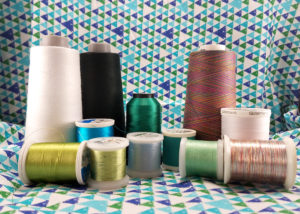
It’s a common, and understandable, question. To put it simply: you need the right tool for the job. I’ll go over needles some other time; today we’re focusing on thread!
Now, you might be tempted to just grab the cheapest spool of thread in white or black that you can find and get started. Please don’t do this. For your sake, for my sake, for your project’s sake! Not all thread is created equal, and it isn’t all created for the same purpose. “But Audrey,” you say, “how do I know what kind of thread to use?” That’s what I’m here for. Let me walk you through it.
*This post may contain affiliate links and we may earn compensation when you click on the links and make a purchase at no additional cost to you.
“All-Purpose” Thread
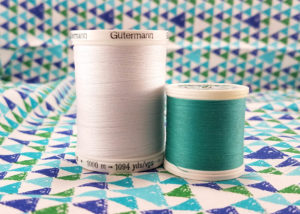
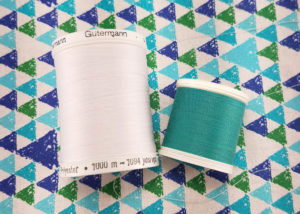
This will be your go-to thread for a majority of projects if you are a sewist and not an embroiderer. This thread is made out of Polyester or Cotton, or sometimes a blend of the two. If anyone starts talking about “weights” of thread, this would fall in the 40-50 weight range, depending on the brand. This thread is suitable for machine and hand sewing, and you can find it in every color of the rainbow these days. You can use it on everything from lightweight fabric to heavy fabric. I like to use Gütermann (this large spool is great for all my common everyday projects), Mettler (here’s another large spool to keep on hand), and Madeira (they have a nice box set with 18 different colors to get you started).
When picking out an all-purpose thread, try to make sure it’s not too linty. Thread with a lot of lint is gonna have you stopping to clean out your sewing machine much more frequently, and can gum up the inner workings if you’re not diligent. To check, I’ll hold a spool of thread up to the light and look for “fuzz” on the edges. If there’s a lot of fuzz, I don’t buy it. You can also pull out the tail of the thread and look at a single thread. Does it look like a nice solid line, or does it look like a little caterpillar? Buy the solid one.
Embroidery Thread
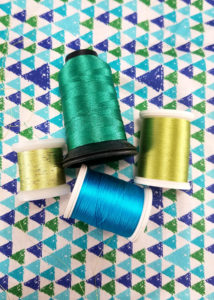
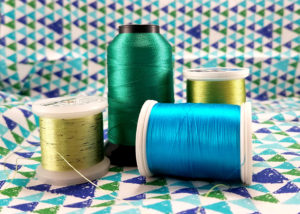
This one sounds pretty self-explanatory, right? Embroidery thread is used for embroidery, duh. However… there are different kinds of embroidery thread. The two most common types are Rayon and Polyester. Either type will have a really shiny quality to the thread that you don’t see in All-Purpose Thread. Embroidery thread is meant to look really pretty, so that it pops when it is stitched into an embroidery design. It is usually more expensive than All-Purpose thread. Beyond embroidery, it is also a really nice option for topstitching and decorative stitching. The sheen of the thread can really make these stitches pop on a project and give that little extra somethin’.
There is some debate over which kind of embroidery thread is better, Rayon or Polyester? I personally use both, but let me break down the differences as I have been told. Rayon embroidery thread is said to have a nicer sheen and be prettier than Polyester. It is also a plant-based product (Rayon is made from wood pulp), if that’s any sort of deciding factor for you. Polyester embroidery thread is said to be more color-fast than Rayon, and sturdier, so it may hold up better to a lot of washings than Rayon. When I still worked at a sewing store, I would recommend Polyester embroidery thread to people embroidering projects for children.
Now, in my personal experience… I have not noticed enough of a difference between Rayon and Polyester threads to go out of my way to buy one or the other. I routinely use both types of thread in the same project without any issues. I can’t even tell them apart when it’s done, so I can’t say that I notice much difference in sheen. Find a brand that you like and that your machine likes. Machines can be picky, so let the machine be picky and use that. What I would not do is purchase the embroidery thread that’s like $1 per spool or less on Amazon. If it’s that cheap… you get what you pay for. Maybe you get a couple nice spools that work okay. But what do you do when you need more of that color? I don’t think they’ll guarantee you can find it again.
My favorite brands for embroidery are Floriani (which you can only get through authorized dealers), Madeira Rayon (here is a nice 18 spool starter pack), Madeira Polyneon (here is another 18 spool starter pack), and I’ve had good luck with Sulky (here is a large single spool for colors you use all the time).
Heavy Duty Thread
Now we’re getting into some specialty threads. Heavy Duty thread is generally made out of nylon or polyester. This thread is meant for heavy duty fabrics and projects, like canvas and denim being made into camping gear, or sporting equipment. It’s made to withstand a lot of wear and tear. Some of it is specifically marked for outdoor use, and it will be treated to be UV resistant so that it doesn’t rot in the sun. I use this thread pretty much anytime I’m making something that’s going to hold a lot of weight, at least for those load-bearing seams. Gütermann makes a nice extra-strong thread for this purpose.
Quilting Thread
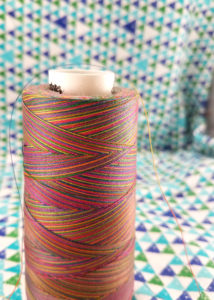
Quilting thread is going to appear very similar to All-Purpose thread at first. It is usually made of Cotton or Polyester. This thread is going to be mercerized to give it a nicer finish than standard All-Purpose thread. It will also be manufactured to be less linty. On a long arm quilting machine, too much lint can really slow down your quilting process. Those machines move so fast that you’ll have a gorgeous little ball of lint built up around your needle and in your bobbin area in no time, and you don’t want to be stitching that into your quilt. My favorite quilting threads are King Tut (here’s a gorgeous variegated thread), Madeira Aeroquilt (here is a nice starter set with 8 standard colors), and Signature (here’s a giant spool of white, so you never run out in the middle of a quilt).
Metallic Thread
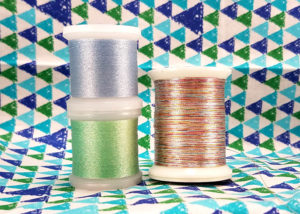
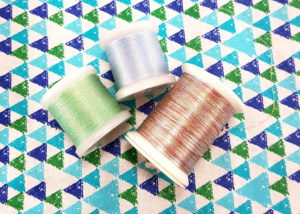
Metallic thread is kind of a sub-category of embroidery thread. You will usually use it for embroidery, but it can also be fun to use on topstitching or decorative stitches. It is exactly what the name implies, thread that is metallic. It can be made in a variety of ways, but the most common is a polyester core that is wrapped with metal foil. You can also find “holographic” thread that is a single strand of thin, holographic plastic. Metallic threads are very fragile and can be frustrating to use until you learn all of the tricks. If I’m going to use metallic thread, Madeira metallic is my go-to.
Serger Thread
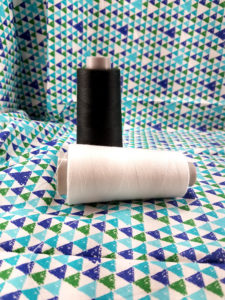
A serger uses at least 2 spools of thread to overlock your seams and finish off the edges. Serger thread is a finer weight than standard thread to prevent the seams from getting too bulky. Serger threads usually come in larger cone sizes because so much thread is used in this style of sewing. I’ve had great success with Gütermann serger thread and Madeira Aerolock.
Specialty Threads
All other threads I consider “specialty” threads, meaning that they are used so infrequently or for such specific items that you often won’t have it on hand until you come across that one project that uses it. This includes elastic thread, clear thread, denim thread, and other types of thread that I’ve never even used. I hope someday I’ll have used every kind of thread there is. I’ll be sure to share with you guys as I use new and interesting thread types!
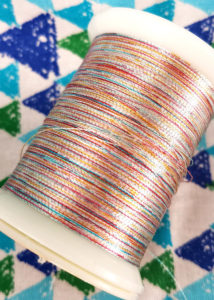
Until next time,
Audrey


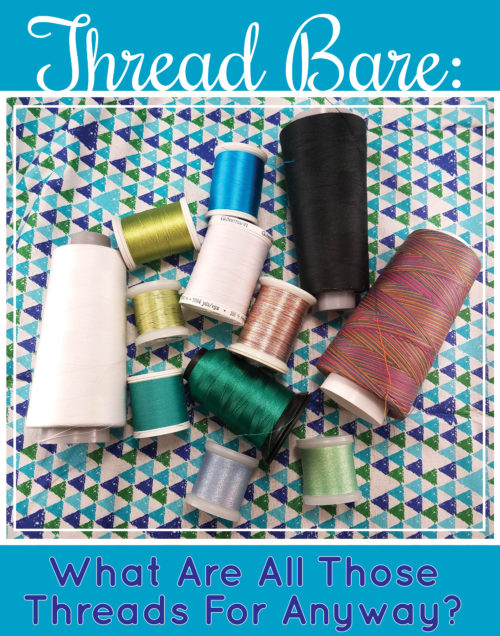
5 thoughts on “Thread Bare: What Are All Those Threads For Anyway?”
I didn’t realize how many different types of threads there are! You did a great job explaining each one!
Nice job explaining. I wrote down what to buy for quilting.
Great information on the use of different threads. I want to practice more with embroidery when I find the time. 🙂
With havin so much content do you ever run into any issues of plagorism or copyright violation? My blog has a lot of exclusive content I’ve either authored myself or outsourced but it seems a lot of it is popping it up all over the internet without my agreement. Do you know any techniques to help protect against content from being stolen? I’d truly appreciate it.